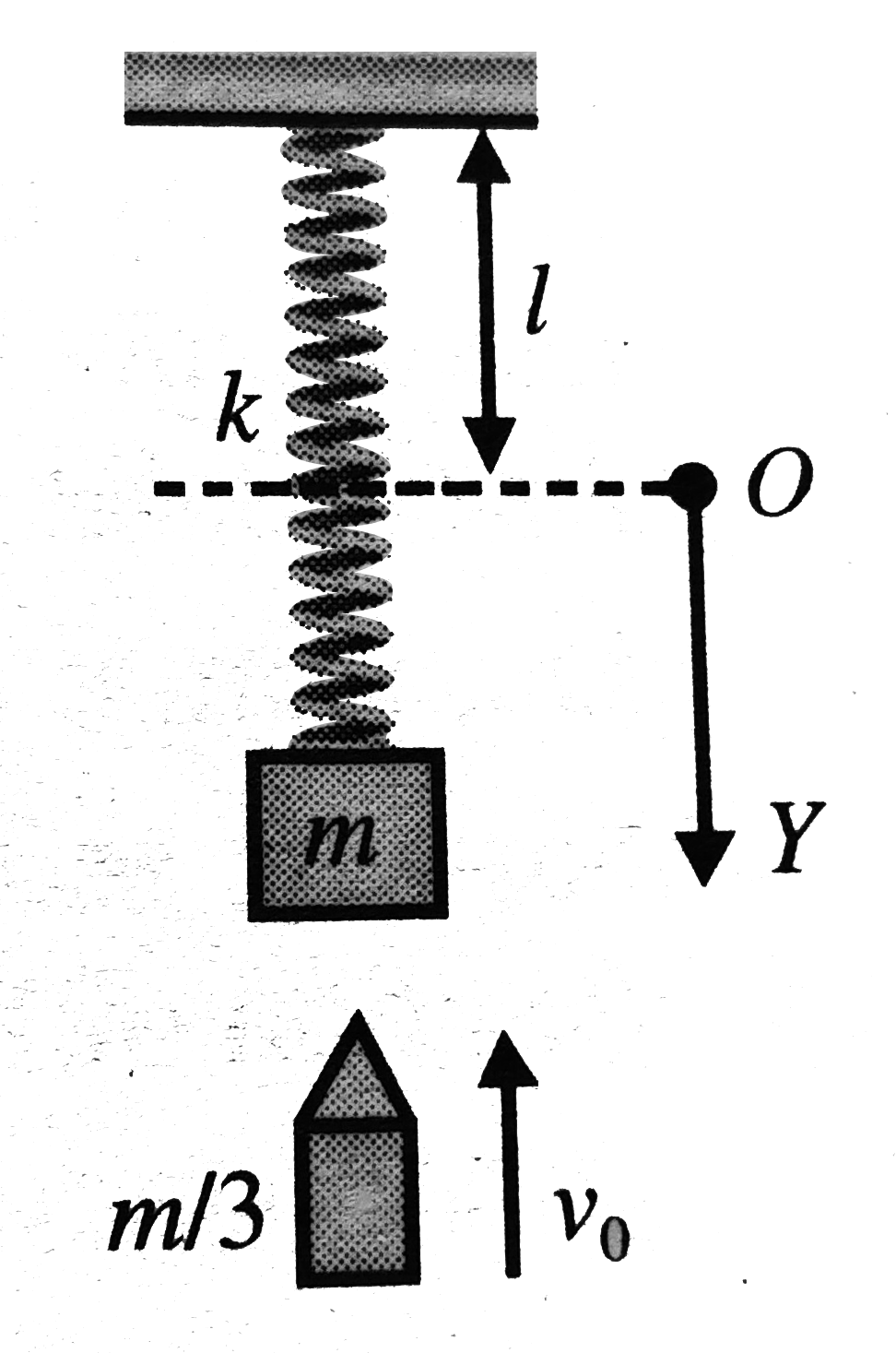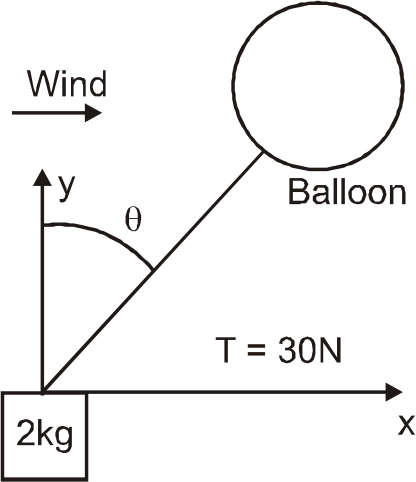A ballon has 2 g of air . A small hole is pierced into it . The air comes out with relative velocity 4 m/s . If the balloon shrinks completely in 2.5 s , the average force acting on the balloon is
0.008N
0.0032 N
8 N
3.2 N
To find the average force acting on the balloon as the air escapes, we can follow these steps:
Step 1: Understand the Problem
We have a balloon containing 2 grams of air, and air escapes through a small hole with a relative velocity of 4 m/s. The balloon shrinks completely in 2.5 seconds. We need to calculate the average force acting on the balloon during this time.
Step 2: Convert Mass to Kilograms
Since the standard unit of mass in physics is kilograms, we need to convert the mass of air from grams to kilograms:
Mass of air=2 g=2×10−3 kg
Step 3: Calculate Change in Momentum
The change in momentum (Δp) can be calculated using the formula:
Δp=Δm⋅vrelative
where Δm is the mass of air that escapes and vrelative is the velocity of the escaping air.
Since the entire mass of air will eventually escape, we can take Δm=2×10−3 kg and vrelative=4 m/s:
Δp=(2×10−3 kg)⋅(4 m/s)=8×10−3 kg m/s
Step 4: Calculate Average Force
The average force (Favg) can be calculated using the formula:
Favg=ΔpΔt
where Δt=2.5 s:
Favg=8×10−3 kg m/s2.5 s=8×10−32.5=3.2×10−3 N
Step 5: Final Result
Thus, the average force acting on the balloon is:
Favg=3.2×10−3 N
We have a balloon containing 2 grams of air, and air escapes through a small hole with a relative velocity of 4 m/s. The balloon shrinks completely in 2.5 seconds. We need to calculate the average force acting on the balloon during this time.
Since the standard unit of mass in physics is kilograms, we need to convert the mass of air from grams to kilograms:
Mass of air=2 g=2×10−3 kg
The change in momentum (Δp) can be calculated using the formula:
Δp=Δm⋅vrelative
where Δm is the mass of air that escapes and vrelative is the velocity of the escaping air.
Δp=(2×10−3 kg)⋅(4 m/s)=8×10−3 kg m/s
The average force (Favg) can be calculated using the formula:
Favg=ΔpΔt
where Δt=2.5 s:
Favg=8×10−3 kg m/s2.5 s=8×10−32.5=3.2×10−3 N
Thus, the average force acting on the balloon is:
Favg=3.2×10−3 N
Topper's Solved these Questions
- CENTRE OF MASS, IMPULSE AND MOMENTUMBOOK - DC PANDEY ENGLISHCHAPTER - CENTRE OF MASS, IMPULSE AND MOMENTUMEXERCISE - More a than one option is Correct
1 Videos
- CENTRE OF MASS, IMPULSE AND MOMENTUMBOOK - DC PANDEY ENGLISHCHAPTER - CENTRE OF MASS, IMPULSE AND MOMENTUMEXERCISE - Comprehension type questions
15 Videos
- CENTRE OF MASS, IMPULSE AND MOMENTUMBOOK - DC PANDEY ENGLISHCHAPTER - CENTRE OF MASS, IMPULSE AND MOMENTUMEXERCISE - Comprehension type questions
15 Videos
- CENTRE OF MASSBOOK - DC PANDEY ENGLISHCHAPTER - CENTRE OF MASSEXERCISE - Medical entrances gallery
27 Videos
- CENTRE OF MASS, LINEAR MOMENTUM AND COLLISIONBOOK - DC PANDEY ENGLISHCHAPTER - CENTRE OF MASS, LINEAR MOMENTUM AND COLLISIONEXERCISE - Level 2 Subjective
21 Videos
Similar Questions
A balloon os mass 2 KG is rising up with an acceleration of 4ms2 . The upward force acting on the balloon is (g = 10 ms^-2)
View Solution
A block of mass m is suspended from one end of a light spring as shown. The origin O is considered at distance equal to natural length of the spring from the ceiling and vertical downwards direction as positive y-axis. When the system is in equilibrium a bullet of mass m3 moving in vertical up wards direction with velocity v0 strikes the block and embeds into it. As a result, the block (with bullet embedded into it) moves up and start oscillating. Based on the given information, answer the following question:
Q. The time taken by the block bullet system to move from y=mgk (initial equilibrium position) to y=0 (natural length of spring) is (A represents the amplitude of motion)
View Solution
Knowledge Check
A particle moves in the direction of east for 2s with velocity of 15m/s .Then it moves towards north for 8s with a velocity of 5m/s . The average velocity of the particle is (in m/s)
A1 m/sB5 m/sC7 m/sD10 m/s
A body is projected into air with a velocity (3i + 4j + 5k)m/s. Taking x-y plane as base and Z axis as vertical, the range of projectile (g =10m/s2)
View SolutionA balloon having mass 'm' is filled with gas and is held in hands of a boy. Then suddenly it gets released and gas starts coming out of it with a constant rate. The velocity of the ejected gas is 2m/s with respect to the balloon. Find out the velocity of the balloon when the mass of gas is reduced to half :-
View SolutionA balloon containing 1 mole air at 1 atm initially is filled further with air till pressure increases to 4 atm. The intial diameter of the ballon is 1 m and the pressure at each stage is proportional to diameter of the balloon. How many moles of air added to change the pressure from 1 atm to 4 atm.
View SolutionThe force of buoyancy exerted by the atmosphere on a balloon is B in the upward direction and remains constant. The force of air resistance on the balloon acts opposite to the direction of velocity and is proportional to it. The balloon carries a mass M and is found to fall down near the earth's surface with a constant velocity v. How uch mass hsould be removed from teh balloon so that it may rise with a constant velocity v?
View SolutionA balloon is tied to a block. The mass of the block is 2kg. The tension of the string between the balloon and the block is 30N. Due to the wind, the string has an angle 0 relative to the vertical direction. cosθ=4/5and sinθ=3/5. Assume the acceleration due to gravity is g=10m/s2. Also assume the block is small so the force on the block from the wind can be ignored. Then the x-component and the y-component of the acceleration a of the block.

View SolutionA balloon is tied to a block. The mass of the block is 2kg. The tension of the string between the balloon and the block is 30N. Due to the wind, the string has an angle 0 relative to the vertical direction. cosθ=4/5and sinθ=3/5. Assume the acceleration due to gravity is g=10m/s2. Also assume the block is small so the force on the block from the wind can be ignored. Then the x-component and the y-component of the acceleration a of the block.

View SolutionA balloon is going upwards with a constant velocity 15m/s. When the ballooon is at 50 m height, a stone is dropped outside from the balloon. How long will stone take to reach at the ground? (take g=10m/s2)
View Solution
